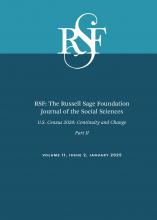Abstract
Using the data on 6.8 million individuals from the 1980, 1990, and 2000 decennial censuses and the 2010 and 2019 American Community Surveys, we document changes in living alone over the four decades across five ten-year age groups—twenty-five to thirty-four, thirty-five to forty-four, forty-five to fifty-four, fifty-five to sixty-four, and sixty-five to seventy-four—for each gender and race group. The analysis reveals no substantial change in living alone for most groups over time, save older men showing an increase in the share of solo living. Four-year-college-educated men are more likely to live alone than less-educated counterparts at younger ages. The relationship is reversed at older ages. This educational crossover is not observed among women, who show educational convergence only at older ages. Blacks are more likely to live alone than whites, though the age and education patterns are similar.
- © 2025 Russell Sage Foundation. Park, Hyunjoon, Matthew Sheen, and Paula Clark. 2025. “Living Alone for Black and White Men and Women over Four Decades, 1980–2019.” RSF: The Russell Sage Foundation Journal of the Social Sciences 11(2): 26–45. https://doi.org/10.7758/RSF.2025.11.2.02. The authors thank participants of the RSF journal conference, held June 8–9, 2023, for their comments and suggestions on the earlier version. They are grateful for Dr. Andrew Taeho Kim’s help for creating figures included in the paper. Direct correspondence to: Hyunjoon Park, at hypark{at}sas.upenn.edu, Department of Sociology, University of Pennsylvania, 3718 Locust Walk, Philadelphia, 19104, United States.
Open Access Policy: RSF: The Russell Sage Foundation Journal of the Social Sciences is an open access journal. This article is published under a Creative Commons Attribution-NonCommercial-NoDerivs 3.0 Unported License.






